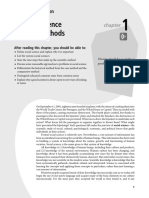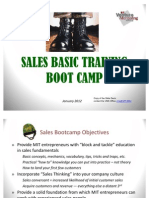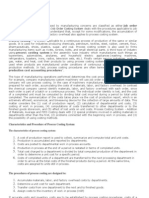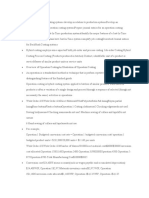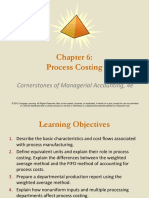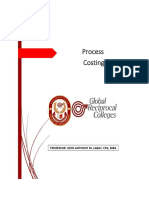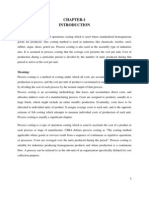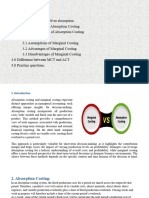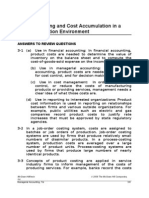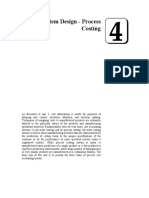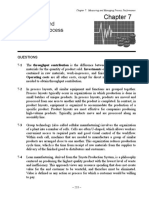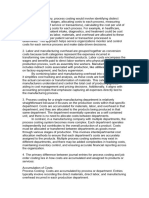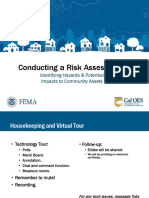0 ratings0% found this document useful (0 votes)
4 viewsProcess Costing
Process Costing
Uploaded by
Syafira Agnia LillaCopyright:
© All Rights Reserved
Available Formats
Download as PPTX, PDF, TXT or read online from Scribd
Process Costing
Process Costing
Uploaded by
Syafira Agnia Lilla0 ratings0% found this document useful (0 votes)
4 views34 pagesOriginal Title
Process costing
Copyright
© © All Rights Reserved
Available Formats
PPTX, PDF, TXT or read online from Scribd
Share this document
Did you find this document useful?
Is this content inappropriate?
Copyright:
© All Rights Reserved
Available Formats
Download as PPTX, PDF, TXT or read online from Scribd
Download as pptx, pdf, or txt
0 ratings0% found this document useful (0 votes)
4 views34 pagesProcess Costing
Process Costing
Uploaded by
Syafira Agnia LillaCopyright:
© All Rights Reserved
Available Formats
Download as PPTX, PDF, TXT or read online from Scribd
Download as pptx, pdf, or txt
You are on page 1of 34
©Cengage Learning Asia Pte Ltd 2008
1. Cite examples of businesses in which process costing is
used.
2. Explain three common patterns of production flow.
3. Determine if a process cost system can be used, based
on an examination of the production environment.
4. Calculate equivalent production and departmental unit
costs.
5. Prepare a departmental cost of production report based
on average costing.
6. Prepare general journal entries to record production
costs in a process cost system.
7. (Appendix) Prepare a departmental cost of production
report based on fifo costing.
©Cengage Learning Asia Pte Ltd 2008
An important objective of any costing
system is to determine the cost of the
goods or services produced by the
company.
©Cengage Learning Asia Pte Ltd 2008
. In a process cost system, materials, labor,
and factory overhead are charged to cost
centers. The cost assigned to each unit is
determined by dividing the total cost charged
to the cost center by the number of units
produced.
©Cengage Learning Asia Pte Ltd 2008
Cost centers are usually departments but
may be processing centers within
departments. The primary requirement is
that all the products manufactured within the
cost center during the period must be the
same in terms of resources consumed;
otherwise, process costing will distort
products’ costs.
©Cengage Learning Asia Pte Ltd 2008
In manufacturing firms, production can take
place in several departments. Each
department performs a specific operation
leading to completion of the product.
©Cengage Learning Asia Pte Ltd 2008
In a process cost system, materials, labor,
and factory overhead are generally
charged to the producing departments;
however, if a department is organized into
two or more cost centers, process costing
can still be used, as long as the units of
product manufactured within the cost
center during the period are
©Cengagehomogeneous.
Learning Asia Pte Ltd 2008
Process costing, when practical, is
preferable to job order costing because
it generally requires less record
keeping, and less record keeping
means that it costs less to operate.
©Cengage Learning Asia Pte Ltd 2008
Process costing is used when products are
manufactured under conditions of
continuous processing or under mass
production methods where the products
manufactured within a department or other
cost center are homogeneous.
©Cengage Learning Asia Pte Ltd 2008
A product can move through a factory in a
variety of ways. Three different physical
production flow formats associated with
process costing are sequential, parallel, and
selective.
©Cengage Learning Asia Pte Ltd 2008
3. Physical Production Flow
(1)Sequential Product Flow
In sequential product flow, each product
is processed in the same series of steps.
Processing begins in the Cutting
Department where raw materials are
combined and direct labor and factory
overhead costs are added.
©Cengage Learning Asia Pte Ltd 2008
©Cengage Learning Asia Pte Ltd 2008
(2)Parallel Product Flow
In parallel product flow, certain portions
of the work are done simultaneously
and then brought together in a final
process or processes for completion
and transfer to finished goods.
©Cengage Learning Asia Pte Ltd 2008
©Cengage Learning Asia Pte Ltd 2008
3. Physical Production Flow.
(3)Selective Product Flow
In selective product flow, the
product moves to different
departments within the plant,
depending on what final product is
to be produced.
©Cengage Learning Asia Pte Ltd 2008
©Cengage Learning Asia Pte Ltd 2008
(1)Materials Costs
In job order costing, materials requisitions
are the basis for charging direct materials
to specific jobs. In process costing, the
details are reduced because materials are
charged to departments rather than to jobs,
and there are only a few departments using
materials.
©Cengage Learning Asia Pte Ltd 2008
Materials requisition forms may be useful for
control of materials. If the requisitions are not
priced individually, the cost of materials used
can be determined at the end of the
production period through a periodic
inventory approach-that is, adding purchases
to beginning inventory and deducting ending
inventory.
©Cengage Learning Asia Pte Ltd 2008
(2)Labor Costs
The detailed clerical work of accumulating labor
costs by jobs is eliminated in process costing
because labor costs are traced only to
departments. Daily time tickets or clock cards are
used instead of job time tickets. A summary entry
distributes the direct manufacturing payroll to
departments for the period.
©Cengage Learning Asia Pte Ltd 2008
(3)Factory Overhead Costs
Both job order and process costing, the
actual cost of factory overhead is accumulated
in a general ledger control account, and the
details of factory overhead costs are
accumulated in subsidiary records. In the
subsidiary records, each overhead cost item,
such as indirect materials or indirect labor, is
broken down into amounts for each department.
©Cengage Learning Asia Pte Ltd 2008
This detailed information is used as a basis
for planning future costs and for
controlling current costs. As overhead
costs are incurred, they are recorded in a
factory overhead general ledger account
and are posted to the departmental
subsidiary records for overhead.
©Cengage Learning Asia Pte Ltd 2008
(4)Combining Labor and Factory Overhead
Costs
Direct labor being charged separately to
each department by means of a general
journal entry. Increasing levels of
automation cause direct labor to be a
decreasing proportion of total
manufacturing cost.
©Cengage Learning Asia Pte Ltd 2008
Furthermore, in highly automated factories
the distinction between the tasks performed
by direct and indirect labor is often blurred.
Also, factory overhead costs such as
equipment depreciation, power, and
maintenance tend to increase with
automation.
©Cengage Learning Asia Pte Ltd 2008
process costing, all costs chargeable to a
department are summarized in a
departmental cost of production report. The
cost of production report is a worksheet
presenting the amount of costs
accumulated and assigned to production
during a month or other period.
©Cengage Learning Asia Pte Ltd 2008
It is also the source of information for
preparing summary journal entries to record
the cost of units transferred from one
producing department to another and finally
to finished goods inventory.
©Cengage Learning Asia Pte Ltd 2008
ermining the cost of the units transferred
out of a department and those remaining in
ending inventory is essentially an
allocation process. Because costs can
change over time, a cost flow assumption
must be adopted.
©Cengage Learning Asia Pte Ltd 2008
The most common cost flow
assumption used for work in
process inventory is average
costing; therefore, average
costing will be used here for
illustrative purposes.
©Cengage Learning Asia Pte Ltd 2008
equivalent unit is the amount of a resource (such
as materials, labor, or overhead) that is required
to complete one unit of the product.
©Cengage Learning Asia Pte Ltd 2008
©Cengage Learning Asia Pte Ltd 2008
some production processes, the addition of
materials results in an increase in the total
volume or number of units of the product.
For example, in the manufacture of soft
drinks, the syrup is often produced in one
department and carbonated water added in a
subsequent process.
©Cengage Learning Asia Pte Ltd 2008
©Cengage Learning Asia Pte Ltd 2008
The addition of carbonated water increases the
total volume of liquid product to be accounted
for. Increasing the quantity of liquid dilutes the
amount of syrup in each gallon, which in turn
reduces the amount of prior department cost in
each gallon of product produced in the second
department. The increased quantity of liquid
product absorbs the same total amount of
preceding department cost.
©Cengage Learning Asia Pte Ltd 2008
©Cengage Learning Asia Pte Ltd 2008
©Cengage Learning Asia Pte Ltd 2008
You might also like
- Week2 - Elgin F. Hunt, David C. Colander - Social Science - An Introduction To The Study of Society-Routledge (2016)Document25 pagesWeek2 - Elgin F. Hunt, David C. Colander - Social Science - An Introduction To The Study of Society-Routledge (2016)Muhammet100% (1)
- Kent Summers Sales Bootcamp - For Startup Founders With An Engineering BackgroundDocument38 pagesKent Summers Sales Bootcamp - For Startup Founders With An Engineering BackgroundilamontNo ratings yet
- Advancing Your Career Concepts in Professional Nursing by Rose Kearney Nunnery - Test BankDocument10 pagesAdvancing Your Career Concepts in Professional Nursing by Rose Kearney Nunnery - Test BankSandraNo ratings yet
- Job Order Costing: Managerial Accounting 14eDocument26 pagesJob Order Costing: Managerial Accounting 14ecykenNo ratings yet
- NAMRIAs Role For Safer Navigation in The Philippines - 3Document53 pagesNAMRIAs Role For Safer Navigation in The Philippines - 3Cart Luma-angNo ratings yet
- Job Order CostingDocument41 pagesJob Order CostingSyafira Agnia LillaNo ratings yet
- Kaduna State University: PGD in AccountingDocument12 pagesKaduna State University: PGD in AccountingPAUL TIMMYNo ratings yet
- WK 1 - Cost Accounting Techniques Part 1 - HandoutDocument27 pagesWK 1 - Cost Accounting Techniques Part 1 - HandoutEENo ratings yet
- NotesDocument155 pagesNotesZainab Syeda100% (1)
- L6 - Cost Accounting PrinciplessDocument36 pagesL6 - Cost Accounting PrinciplesshayliyesusNo ratings yet
- Job Order Costing: Financial and Managerial Accounting 14eDocument26 pagesJob Order Costing: Financial and Managerial Accounting 14eAlondra Joan MararacNo ratings yet
- Job-Order Costing Versus Process CostingDocument6 pagesJob-Order Costing Versus Process CostingArnin OwonNo ratings yet
- AB-B - Rizky Fadillah Salam - Assignment Week 4 5Document13 pagesAB-B - Rizky Fadillah Salam - Assignment Week 4 5Reta AzkaNo ratings yet
- Process Costing SystemDocument15 pagesProcess Costing SystemAmmad SheikhNo ratings yet
- Hybrid CostingDocument3 pagesHybrid CostingMaridel MapaladNo ratings yet
- ACCA105Document2 pagesACCA105Shane TabunggaoNo ratings yet
- Operation CostingDocument5 pagesOperation CostingAshmanur RhamanNo ratings yet
- Proses Costing and Job Order CostingDocument9 pagesProses Costing and Job Order CostingNefvi Desqi AndrianiNo ratings yet
- Ppppppppppppppprocess CostingDocument27 pagesPpppppppppppppprocess CostingJon Jan CronicoNo ratings yet
- Study of Process Accounting Potato Chips Manufacturing IndustryDocument25 pagesStudy of Process Accounting Potato Chips Manufacturing IndustryChandni SinghNo ratings yet
- Chapter 4 Process Costing Rework Scrap Spoilage Joint Product 2015Document17 pagesChapter 4 Process Costing Rework Scrap Spoilage Joint Product 2015Amha SeyoumNo ratings yet
- Business Process Analysis: 2.6 Cost SheetDocument9 pagesBusiness Process Analysis: 2.6 Cost SheetDarshitNo ratings yet
- Final Assignment On Costing MethodsDocument17 pagesFinal Assignment On Costing MethodsAlamin MohammadNo ratings yet
- Kinney 8e - IM - CH 06Document19 pagesKinney 8e - IM - CH 06Nonito C. Arizaleta Jr.No ratings yet
- Kinney 8e - IM - CH 06Document19 pagesKinney 8e - IM - CH 06JM TylerNo ratings yet
- Bbe 2103 (Cost Accounting) Lecture Notes (Topic 3 - Process Costing)Document16 pagesBbe 2103 (Cost Accounting) Lecture Notes (Topic 3 - Process Costing)SAMSON OYOO OTUKENENo ratings yet
- Process Costing: Cornerstones of Managerial Accounting, 4eDocument72 pagesProcess Costing: Cornerstones of Managerial Accounting, 4eحارث عباسیNo ratings yet
- Kinney 8e - CH 06Document19 pagesKinney 8e - CH 06Ashik Uz ZamanNo ratings yet
- Activity-Based Costing: Managerial Accounting 14eDocument21 pagesActivity-Based Costing: Managerial Accounting 14ecykenNo ratings yet
- CA - Topic 3 - 202405051917 - 04457Document21 pagesCA - Topic 3 - 202405051917 - 04457vooyinyin6No ratings yet
- Process Cost Systems: Managerial Accounting 14eDocument22 pagesProcess Cost Systems: Managerial Accounting 14ecykenNo ratings yet
- Chapter 9 Cost Accounting and Control QuestionsDocument2 pagesChapter 9 Cost Accounting and Control Questionsvaleriejustine32205No ratings yet
- Job-Order Costing: Cornerstones of Managerial Accounting, 4eDocument69 pagesJob-Order Costing: Cornerstones of Managerial Accounting, 4eLindaWidyanaNo ratings yet
- Cac NotesDocument14 pagesCac Notescoco credo100% (1)
- Process Cost TheoryDocument2 pagesProcess Cost Theorysalonidhyani15No ratings yet
- AFAR H01 Cost AccountingDocument7 pagesAFAR H01 Cost AccountingPau SantosNo ratings yet
- Cost For p2Document10 pagesCost For p2Elizabeth Zausa AseoNo ratings yet
- Process Costing ProjectDocument55 pagesProcess Costing ProjectshaileshNo ratings yet
- GRC Process Costing ModuleDocument17 pagesGRC Process Costing ModuleKirk EscanillaNo ratings yet
- Procedures For Materials, Labor, and Factory Overhead CostsDocument4 pagesProcedures For Materials, Labor, and Factory Overhead CostsGeorge ParackaNo ratings yet
- U04 Cost Accumulation SystemDocument30 pagesU04 Cost Accumulation SystemIslam AhmedNo ratings yet
- AdvantagesDocument6 pagesAdvantagesAqsa_afridi0062No ratings yet
- Unit 4th Cost Acc.Document4 pagesUnit 4th Cost Acc.Harish PrajapatNo ratings yet
- Introduction To Process CostingDocument29 pagesIntroduction To Process Costingshersudsher67% (3)
- Seu Act500 Module02 PPT Ch02Document37 pagesSeu Act500 Module02 PPT Ch02Fatima WassliNo ratings yet
- Job Order CostingDocument6 pagesJob Order CostingJomar Teneza100% (1)
- Process CostingDocument15 pagesProcess CostingyebegashetNo ratings yet
- 1Document3 pages1cruellaNo ratings yet
- chapter-9Document48 pageschapter-9neraizagutierrez11No ratings yet
- Lesson 6-Activity Based Costing SystemDocument11 pagesLesson 6-Activity Based Costing SystemOmotayo OpeniyiNo ratings yet
- Idle CostDocument4 pagesIdle CostBhawna GosainNo ratings yet
- Process CostingDocument43 pagesProcess Costingjinalshah21097946No ratings yet
- MCT & ActDocument30 pagesMCT & Actmablekos13No ratings yet
- Chapter03 E7Document99 pagesChapter03 E7conanthegreat0293% (14)
- System Design - Process CostingDocument38 pagesSystem Design - Process CostingAbuShahidNo ratings yet
- CHP 17 SlidesDocument35 pagesCHP 17 SlidesNoor PervezNo ratings yet
- RAR (Kaplan - Solutions Chapter 7)Document39 pagesRAR (Kaplan - Solutions Chapter 7)ridha azka rNo ratings yet
- Cost Accouting-JOCDocument3 pagesCost Accouting-JOCAli ImranNo ratings yet
- Activity 1 - Job Order Vs Process CostingDocument2 pagesActivity 1 - Job Order Vs Process Costingarabella yulipNo ratings yet
- Process Costing ControlDocument7 pagesProcess Costing Controlvijayadarshini vNo ratings yet
- Job Costing and Process CostingDocument3 pagesJob Costing and Process CostingUmair Siyab100% (1)
- Job-Order Costing: Managerial Accounting: The Cornerstone of Business Decisions, 4eDocument69 pagesJob-Order Costing: Managerial Accounting: The Cornerstone of Business Decisions, 4eNatasha HilsonNo ratings yet
- The Forgotten PathDocument2 pagesThe Forgotten PathDamith AbeysekeraNo ratings yet
- 8.1 Abiotic & Biotic ComponentsDocument10 pages8.1 Abiotic & Biotic ComponentsMohamad EffendiNo ratings yet
- Cognitive Biases and Heuristics in Human Decision Making (PDFDrive)Document140 pagesCognitive Biases and Heuristics in Human Decision Making (PDFDrive)AXIONAXIONNo ratings yet
- Total True Strength 90-Day Challenge: Advanced TrackDocument6 pagesTotal True Strength 90-Day Challenge: Advanced TrackParth AgrawalNo ratings yet
- Pitch-Deck TemplateDocument16 pagesPitch-Deck Templateyyscribd100% (1)
- Autacoids: (Histamine, Serotonin, Eicosanoids, Kinins)Document31 pagesAutacoids: (Histamine, Serotonin, Eicosanoids, Kinins)Micah MonteNo ratings yet
- Invoice 620804Document1 pageInvoice 620804qwrhhemNo ratings yet
- Famous No Homework QuotesDocument6 pagesFamous No Homework Quoteszikim0fak0f2No ratings yet
- Heal Your Soul With Sound Therapy - Vibrational Healing - Sound Healing For BeginnersDocument14 pagesHeal Your Soul With Sound Therapy - Vibrational Healing - Sound Healing For BeginnersrenderthyshaftNo ratings yet
- The Virtues and Etiquettes of Memorising Qur'anDocument8 pagesThe Virtues and Etiquettes of Memorising Qur'anAljannah Da'wah CentreNo ratings yet
- Unit 2 Mental and Physical DevelopmentDocument146 pagesUnit 2 Mental and Physical DevelopmentTrâm Đặng Cao NgọcNo ratings yet
- SHS CAI Users Guide 10.27.2023Document91 pagesSHS CAI Users Guide 10.27.2023Datuali DimalanasNo ratings yet
- Avoir in French Conjugation, Tenses & ExamplesDocument1 pageAvoir in French Conjugation, Tenses & Examplesgracebon26No ratings yet
- Pathogenesis and Pathophysiology of EpilepsyDocument22 pagesPathogenesis and Pathophysiology of EpilepsyRatuNadiaMaharani100% (1)
- Esab Peg-1Document19 pagesEsab Peg-1Base ESABNo ratings yet
- Liugong 938l Wheel Loader Parts ManualDocument20 pagesLiugong 938l Wheel Loader Parts Manualviolet100% (71)
- Cambridge IGCSE: CHEMISTRY 0620/42Document12 pagesCambridge IGCSE: CHEMISTRY 0620/42Manya PunjabiNo ratings yet
- Pengembangan Metode Promosi Kesehatan Tentang Rabies Untuk Peningkatan Pengetahuan Siswa Sekolah DasarDocument10 pagesPengembangan Metode Promosi Kesehatan Tentang Rabies Untuk Peningkatan Pengetahuan Siswa Sekolah DasarDian PuspitasariNo ratings yet
- Seattle Pump and Equipment CatalogDocument195 pagesSeattle Pump and Equipment CatalogXavier PincayNo ratings yet
- Geology Practical 1Document20 pagesGeology Practical 1Huzefa Ali100% (1)
- Dolphs Varnishs Resin ChartDocument3 pagesDolphs Varnishs Resin ChartFernando Rodriguez100% (1)
- Harrison Chapter5Document7 pagesHarrison Chapter5Zahirul Haq100% (1)
- Kyokai WhitepaperDocument14 pagesKyokai WhitepaperChuza LostNo ratings yet
- Chapter 3 - Double IntegrationDocument26 pagesChapter 3 - Double Integrationpeter wongNo ratings yet
- G318 Mod2 RiskAssessmentDocument82 pagesG318 Mod2 RiskAssessmentsdfwefNo ratings yet
- Mirth Data Sheet Mirth Connect 3 5 User GuideDocument350 pagesMirth Data Sheet Mirth Connect 3 5 User GuidelevilevideejayNo ratings yet
